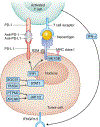Genomic correlates of response to immune checkpoint blockade
- PMID: 30842677
- PMCID: PMC6599710
- DOI: 10.1038/s41591-019-0382-x
Genomic correlates of response to immune checkpoint blockade
Abstract
Despite impressive durable responses, immune checkpoint inhibitors do not provide a long-term benefit to the majority of patients with cancer. Understanding genomic correlates of response and resistance to checkpoint blockade may enhance benefits for patients with cancer by elucidating biomarkers for patient stratification and resistance mechanisms for therapeutic targeting. Here we review emerging genomic markers of checkpoint blockade response, including those related to neoantigens, antigen presentation, DNA repair, and oncogenic pathways. Compelling evidence also points to a role for T cell functionality, checkpoint regulators, chromatin modifiers, and copy-number alterations in mediating selective response to immune checkpoint blockade. Ultimately, efforts to contextualize genomic correlates of response into the larger understanding of tumor immune biology will build a foundation for the development of novel biomarkers and therapies to overcome resistance to checkpoint blockade.
Conflict of interest statement
Competing interests
T.E.K. and K.P.B. declare no competing interests. E.M.V.A. holds consulting roles with Tango Therapeutics, Invitae, Genome Medical, Illumina, Foresite Capital, and Dynamo, receives research support from Bristol-Myers Squibb and Novartis, owns equity in Tango Therapeutics, Genome Medical, Syapse, and Microsoft, received travel reimbursement from Roche/Genentech, and is on an institutional patent for chromatin mutations and immunotherapy response.
Figures



References
Publication types
MeSH terms
Substances
Grants and funding
LinkOut - more resources
Full Text Sources
Other Literature Sources

